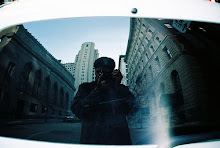
Don’t carry a ton of equipment:
I brought 4 cameras this trip – A Nikon D300 digital SLR, a film Nikon SLR, a Yashica 635 (medium format twin lens reflex), a Bronica SQ-A (medium format SLR) with a whole host of lenses. And which did I use the most? I used the Yashica, 50% of the time, the D300 40% of the time, and the Bronica the remaining 10%. I didn’t use the other Nikon at all. I liked the Yashica the most because of its quiet operation allowing me to take candid photos. Because many people in Israel had never seen a twin lens camera, a lot of curious people would stop me to ask me “Hamatzlama adayin ovedet?” (The camera still works?) And I replied, “Of course… I don’t have it with me for nothing!” Just wearing the camera made my subjects come to me of which most were friendly people. The ordinary camera made me look like a normal tourist – so when I want to get willing subjects, I just don my old 1960s Yashica and go to the street. If you have an old, unique camera, fire it up and take it for a spin – you’ll draw attention giving you the perfect chance to interact with people.
Use one lens if you can help it:
One beautiful thing about my Yashica is that there are essentially no accessories, so I never need to worry about buying another lens! Today, we’re all looking forward to buying the next lens and getting the next latest gizmo for our iPods and iPhones. So to have a device which is an all-in-one package that is entirely mechanical saves me the trouble and worry of having to thinking about how many batteries to bring along, which lenses to bring, etc.
However, the Nikon was not so simple. I brought several lenses: 50mm 1.8, 80-200 2.8, 18-70mm 3.5-4.5, and 35-70mm 2.8 Nikkor lenses. In the end, the 18-70mm Nikkor proved to be the lens I used the most because of its zoom range and faster than usual aperture. It’s really just a royal pain to have to carry around one bag or shove a lens into a pants’ pocket in the situation I might need it. To save my sanity, I just brought a versatile lens that did 85%-90% o
 f what my other lenses could do. I didn’t have quite the fast aperture for low light situations, but if I really needed, I could boost my ISO. After all, the subject matters more than some grain in the image. The 80-200mm lens would draw too much attention to me and was rather unwieldy to carry around all day. The 50mm was great for low light, but what if I wanted to get close? Forget it. So for the zoon range, the lightweight, and relatively quicker aperture the 18-70mm was the lens of choice. In the end, having only one lens allowed me to concentrate on my photography without wasting time and energy carrying and changing lenses.
f what my other lenses could do. I didn’t have quite the fast aperture for low light situations, but if I really needed, I could boost my ISO. After all, the subject matters more than some grain in the image. The 80-200mm lens would draw too much attention to me and was rather unwieldy to carry around all day. The 50mm was great for low light, but what if I wanted to get close? Forget it. So for the zoon range, the lightweight, and relatively quicker aperture the 18-70mm was the lens of choice. In the end, having only one lens allowed me to concentrate on my photography without wasting time and energy carrying and changing lenses.Shoot with a purpose:
My goal as a photographer was document Israel and portray it the way I saw it – as a normal every day country where people live mostly as we Americans live. Having a vision guided me. I learned a verse from the Proverbs that goes beyond religious boundaries; "Without a vision, a nation will perish." Have a vision and move forward.

I learned this lesson on my trip to Patagonia a few years ago. We wanted to be prepared for 'everything' and ended up with an entire carry-on suit case full of camera stuff. It didn't take us long to realize that this was ridiculous. Funny thing, I had never made this mistake before in my travel for scientific expeditions, where space and weight are limiting factors. I guess I needed to learn how to be a tourist.
ReplyDeleteThis is exactly what I discovered too! I brought my small 35mm pinhole camera, mounted it on a small and light tripod with a cable release attached, went out shooting the streets and succeeded in taking so many shots that weren't possible with a typical SLR with big lenses. That's why I love my RF and point-and-shoot cameras most nowadays!
ReplyDelete